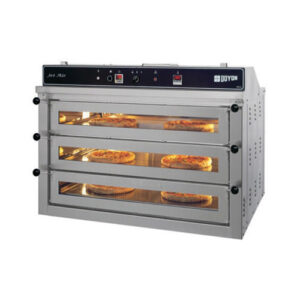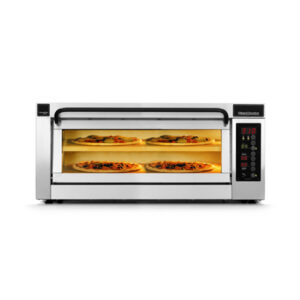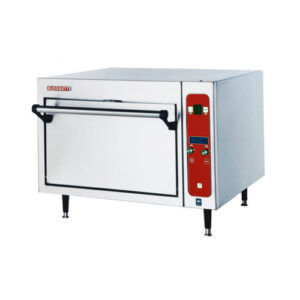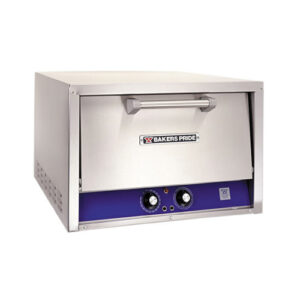13 Jun, 2025
Buying Guide | Commercial Deck Ovens
A Deck Oven is a reliable, heavy-duty appliance ideal for consistent baking of bread, pastries, pizzas, and more! Deck ovens work through the direct radiant heat of the top and bottom of the baking chamber, meaning they produce a result that is difficult to get with other oven types. This is extremely important to bakers and pizzerias that rely on specific crusts, textures, and bake consistency.Since Commercial Deck Ovens are available in various sizes, configurations, and fuel types, having an understanding of the available space, what you will be cooking, and how much volume you will need to produce will help you narrow down your options significantly. This guide will help clarify the most common features and the associated terminology of deck ovens, as well as discuss some considerations to keep in mind before purchase.
What Are Deck Ovens Used For?
Deck ovens are awesome machines specifically designed to create even cooking with radiant heat while keeping an excellent environment for baking.
Breakfast
Deck ovens are perfect for heavy morning service, applying consistent, even heat to items like croissants, pastries, or artisan breads. Stone decks add crispness to bases and a golden finish, ideal for cafe-style breakfasts.
Lunch
Deck ovens produce reliable results when making pizzas, flatbreads, or savory baked goods, and you can control the top and bottom heat for robust textures. Multi-deck ovens allow you to efficiently manage different menu items at once.
Dinner
Deck ovens are great for dinner service. They produce great results when preparing lasagna, roasted vegetables, or casseroles. Steam injection is not necessary, but it will help products retain moisture and achieve the perfect crust to maintain quality and consistency.
How Does A Deck Oven Work ?
The ovens that are deck ovens have radiant heat, while sometimes using conductive heat from the deck surface as well. Heat can be produced by either gas burners or electric heaters and is accomplished by radiating heat evenly through each baking chamber. Typically, ovens will have independent temperature controllers for each deck, allowing for accurate operations for multiple levels. Decks that are made of stone or ceramic will aid in providing stable baking temperatures in the oven and create the desired texture of the bottom crust for every baked item. Some ovens may sometimes have steam injection systems. These steam systems are especially helpful when baking, therefore improving loaf volume and crust shine, which is necessary when producing products such as baguettes.

What You Need To Know!
A good commercial deck oven can enhance product quality, boost output, and improve consistency. A bad commercial deck oven can limit your capacity or cost you more than expected in utilities or maintenance. Below is a checklist of important factors to consider before making your purchase.
Size/Space
Deck ovens can be found in many different sizes, and low or floor models, from small countertop ovens to large free-standing ovens with one to four decks (or even more). Finding the right model may depend on the amount of available kitchen space, the interior deck size (which is usually made to fit full or half sheet pans or 18–inch pizzas), and the height of each deck which could limiting what you can bake.
Power Supply
Deck ovens come in both electric and gas options (with most gas ovens using propane or natural gas). The best option for your operation will depend on your kitchen, your energy efficiency goals, and any installation requirements you may have.
Control
Deck ovens are available in either manual or programmable control types. Manual control types can have dials to adjust top and bottom heat as well as timers, which are best suited for experienced bakers. Programmable types usually have touch screens and can store recipes, offering better consistency and ease of use, especially for less experienced users.
Ventilation
Deck ovens produce considerable heat and, in some cases, steam, which may require specific ventilation measures. Depending on local health and safety regulations, you may need an overhead extraction canopy and sufficient ventilation clearance to ensure safe and compliant operation.
Water Connection
If your deck oven has a steam injection feature, you must supply permanent water. In this case, we strongly recommend you install a commercial water softener to limit limescale buildup and maintain the efficiency of your oven.
Which Deck Oven Is Best?
Even though virtually all deck ovens can appear the same from the outside, decks can vary tremendously in their construction, materials, and performance from model to model. The best deck oven is the one that fits your operational needs. A high-volume pizzeria may emphasize ovens that can recover quickly and have very wide decks openings, while a craft bakery may find value in ovens with advanced steam injection and control of multiple temperature zones. Also, if you operate in multiple locations and choose programmable ovens, you can take advantage of their recipe memory and simpler controls to leverage your valuable time and standardize product quality across locations.
Cleaning
While deck ovens typically don’t feature self-cleaning cycles, they are generally easy to maintain. Regular cleaning involves brushing crumbs and flour off the deck, wiping down external surfaces, and occasionally removing the deck stones for deep cleaning—if the design allows.
Stand
If you are purchasing a countertop or a single-deck model, it is best to purchase a dedicated oven stand with built-in storage shelving for added storage. Some stands also have casters, so you can roll the stand for easy clean-up and maintenance.
Things to Consider:
Price
Electric deck ovens tend to cost less in terms of the initial purchase and installation; while gas ovens often involve higher costs at installation, they may be more cost-effective during operation at an establishment producing a high volume of output.
Efficiency
Gas deck ovens generally preheat quickly and reheat between batches faster than electric ovens, making them ideal for high-volume production. Conversely, electric ovens are easier to control temperature in, and are generally easier to install if there is no gas service to the building.
Cost of Utility
Always compare gas and electric utility costs in your area. This may play an important role in your decision, especially if either utility is much higher in cost.
Availability
Consider local availability when selecting a deck oven, as certain models, sizes, or power types may be easier to source and support in your area.
Common Commercial Deck Oven
|
|
|
|
|
|
|




